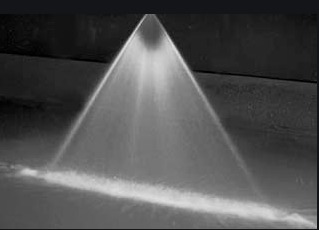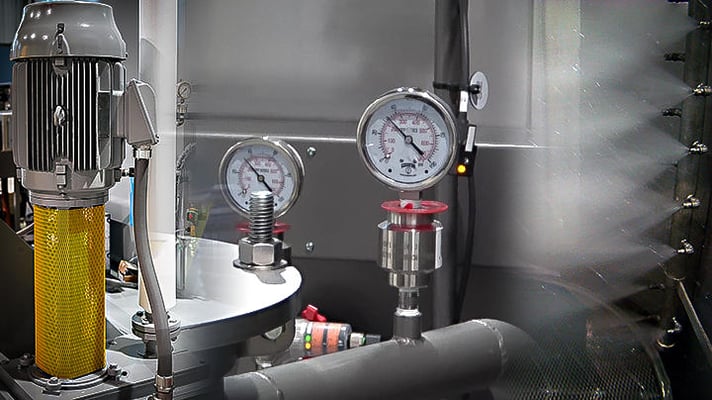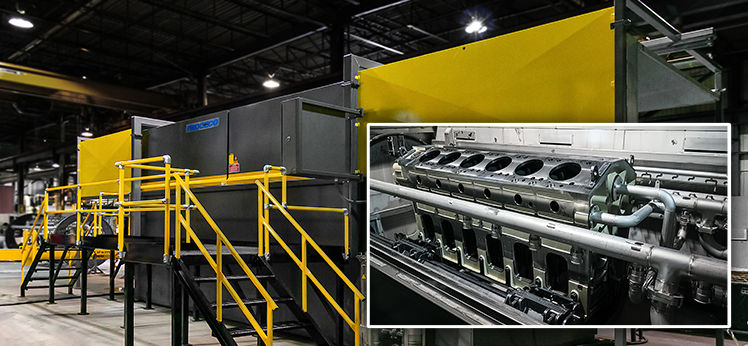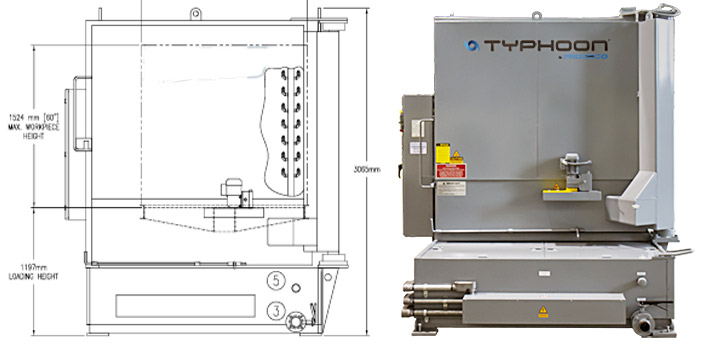Selecting an industrial parts washer is a difficult task that brings many considerations into play. The first one that usually comes up is the size of the machine. Many buyers gravitate toward heavy-duty parts washers that offer extra capacity. While a high capacity can prove useful, one should not forget the impact of size on parameters that affect cleaning performance, including pump size, flow, and pressure.
A typical approach to evaluating a turntable parts washer's performance is to take the surface area of the largest workpiece that can fit inside its cabinet and divide it by the pump horsepower rating. This calculation is a quick and easy way to compare the available cleaning power of two different parts washers, but it makes several assumptions and overlooks many parameters that could negatively impact the performance of the equipment.
Firstly, let's look at what happens when the washer is oversized.
Traditionally, turntable parts washers use flat V-jet spray nozzles. These form a narrow, elliptical, inverted “V” pattern commonly referred to as a tapered spray (Figure 1). The spray density tapers off towards the outside of the elliptical pattern. As the distance from the nozzle tip to the part increases – two things occur: (1) the elliptical pattern enlarges, thereby increasing surface area coverage, and (2) the spray jet velocity decreases, which decreases spray impact, and consequently cleaning performance.

Figure 1: Spray Pattern for a Flat V-jet spray nozzle
To compensate for this loss of impact force, it is crucial to understand the relationship between the pump’s available horsepower, flow rate, and pressure.
Parts washers typically use centrifugal pumps, for which the total horsepower is directly proportional to both pressure and volume delivered. Consequently, an increase in pressure requires more horsepower to maintain a given flow rate. It is possible to increase pressure without changing the pump horsepower but doing so decreases the flow and consequently the amount of cleaning solution coming into contact with the workpiece. Adequate cleaning solution contact is essential to efficiently remove contaminants from the part’s surface.
Let us look at the effect of nozzle sizing to elaborate on the scenario of increasing pressure without changing horsepower and, hence reducing the flow. Spray nozzles deliver spray through a precisely sized hole (opening) with a given surface area. The following equation explains the spray velocity (impact) delivered by the nozzle opening.
V = Q / A
where: V = velocity, Q = flow, and A = area of nozzle opening
This equation denotes that to increase velocity, we need either more flow or a smaller nozzle opening. Since pressure relates to velocity, this clearly demonstrates why increasing pressure without increasing horsepower reduces the flow. Based on the equation, achieving the desired pressure requires a significant nozzle area reduction. In washer design, the remedy to this scenario is to reduce the number of nozzles and adjust their size to deliver sufficient flow to each nozzle and thereby generate the required pressure.
Assuming we have achieved an increase in pressure by reducing the number and/or size of nozzles, and there are enough of them to fully cover the workpiece - the nozzle proximity to the part must also be close enough to ensure that there is sufficient spray impact on the workpiece. Optimally, spray nozzles must be no less than 16 inches away from the part for the increased pressure effect to provide enough impact for cleaning.
However, as mentioned above, if the distance from the nozzle tips to the part increases, velocity decreases thus reducing the spray impact. So, the gain from increased pressure is diminished by oversizing the washer in relation to the part. One way to compensate for this drawback is to increase the pump’s horsepower with more flow and pressure.
Conversely, larger pumps are more costly both to purchase and to operate. Considering that an oversized industrial parts washer already costs more upfront, adding a bigger pump makes it even more economically unattractive. When purchasing a parts washer, it is important to consider the interdependence between flow, pressure, and size. If the application requires cleaning multiple parts with different geometry, a good rule of thumb is to size the machine for 80% of the parts to limit the energy wasted to accommodate the other 20%. For example, we can compare the energy consumption between a 20HP and 30HP pump. Assuming 8 hours of operation; the smaller pump will then consume 120kWh versus 180kWh for the 30HP pump. This 50% increase in energy consumption by the larger pump will translate to about $2,000 per year in additional operating costs (estimated electricity cost of $0.13/kWh).
Upgrading pump horsepower and flow also directly impacts the energy required to heat the solution. The additional pressure and flow at the nozzles both cause loss of energy due to increased atomization and spraying. Atomization occurs when there is a sudden pressure change, which transforms the solution spray into fine particles or droplets. The greater the pressure differential, the greater the atomization effect. This is precisely the case with spray nozzles, where the fluid pressure transforms into velocity as soon as it exits the nozzles. As the solution droplets are lighter and transform into vapor that is carried away by the exhaust, more atomization equals more energy loss. The increased flow only worsens things as it generates more droplets in a given time.
To compensate for the loss through exhaust and additional spraying, a washer equipped with a 50HP pump at a flow of 400 gal/min requires 25% more heat input than that of a washer with a 25HP pump delivering 280 gal/min.
To summarize, one can try to compensate for an oversized parts washer by changing the nozzles or the pump, but since all parameters affecting cleaning performance are interrelated, improving any one parameter means sacrificing another.
With more than 45 years of engineering experience in the parts cleaning industry, PROCECO engineers can help you with your application and make sure the proposed washer is best suited for your specific application.



